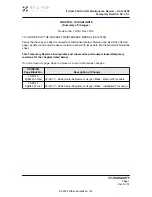
DOCUMENT NUMBER:
L500-912.820 ISSUE JUL 20, 2016
AMENDMENT: 00
DATE: --
CHAPTER-
PAGE 3-21
MAINTENANCE MANUAL STEMME S12
3.4.10.1
DESIGN OF VARIABLE PITCH PROPELLER
The numerical positions in the following text refer to the propeller diagram (see figure »3.4.10 a/b«).
The propeller blades (1) are hinged in a forked mounting plate (4). The complete assembly, con-
sisting of the fork, blade and hub, is rotated in order to set the pitch angle of the blade. The hollow
axle (3) houses a spiral torsion spring (23) to fold the blade by means of a cam lever (22) that fits
into the aperture for the buffer-stop in the propeller blade.
Electrically heated expanding servo-elements (15) actuate the blade pitch mechanism. On
achieving their activating temperature, these expanding servo elements drive a piston connected
to the propeller blades. All components of blade angle mechanism are double-redundant and
mechanically interconnected by a coupling ring (12) so that both propeller blades always have
identical pitch.
3.4.10.2
PROPELLER BLADES
The propeller blades are manufactured from GFRP (Glass Fiber Reinforced Plastic) material in a
twin shell construction. The shells are of hybrid laminate type (glass, carbon, aramid). Polyure-
thane tape is affixed to the leading edges to improve protection against gravel.
To balance the pressure in the blades with the outside atmosphere there is a 1 mm bore hole in
the blade tip. These holes also drain condensed moisture by centrifugal force.
3.4.10.3
PROPELLER BLADE ANGLE CONTROL MECHANISM
When disconnected from the power supply (unheated), the dilation effect actuator (15) is pushed
inwards via the rocking lever (14) by the spring (20), thus moving the propeller blade into T/O
position via the push-rod (13), the synchronizing ring (12) and the connector (11).
Heating of the servo-element by the heating element (16) generates piston pressure that pushes
the swing-arm/push-rod system into the almost fully extended position, thus rotating the pro-
peller blade against the spring towards high pitch. It is assured, that, in case of heating element
malfunction, propeller blade position is automatically in T/O under all operating conditions.
The transmission of the actuating forces to the fork is effected by the drive pin (10) which is
attached to the fork with an eccentric bolt to allow for accurate setting of propeller blades. The
available range of adjustment of the servo-elements is 12.1 mm / 0.476 in. The stop setting for the
T/O position is adjusted for the fully retracted piston. The range of the blade angle change is set
to 6° 24’, limited by a stop switch.
A mechanical stop is adjusted so that only minimum override of the end position switch setting
is possible (< 6’). The piston movement caused by the two-point control system, result in minor
changes in propeller blade pitch angle with neglectable influence on the propeller behavior.
Содержание S12
Страница 1: ......
Страница 3: ......
Страница 97: ......
Страница 238: ......
Страница 240: ......
Страница 242: ......
Страница 244: ......
Страница 246: ......
Страница 248: ......
Страница 250: ......
Страница 255: ...A FLIGHT CONTROLS PITCH CONTROL AND TRIM ...
Страница 256: ......
Страница 257: ...B FLIGHT CONTROLS LATERAL CONTROL WING FLAP AILERON ...
Страница 258: ......
Страница 259: ...C FLIGHT CONTROLS AIRBRAKE CONTROL ...
Страница 260: ......
Страница 261: ...D FLIGHT CONTROLS RUDDER CONTROL ...
Страница 262: ......
Страница 263: ......
Страница 264: ......
Страница 265: ...E PROPULSION SYSTEM ...
Страница 266: ......
Страница 268: ......
Страница 270: ......
Страница 272: ......
Страница 274: ......
Страница 276: ......
Страница 278: ......
Страница 280: ......
Страница 282: ......
Страница 284: ......
Страница 286: ......
Страница 288: ......
Страница 290: ......
















































